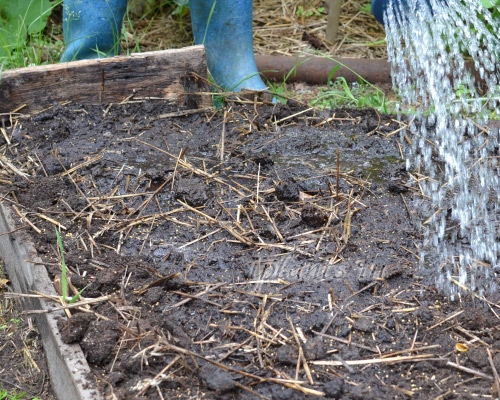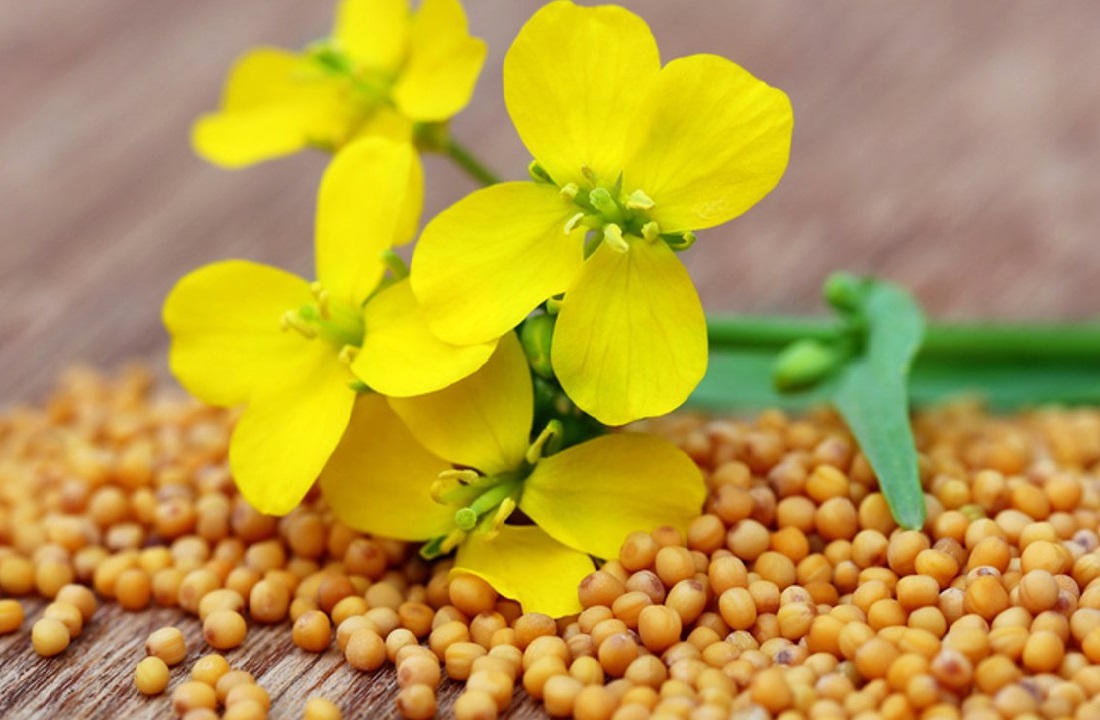White mustard Sinapis alba is an annual plant from the cruciferous family. It is grown from seeds, as a feed crop or as a siderate. Moreover, the use of mustard is popular in agriculture in many countries of the world, although it arose in the Mediterranean region. The plant reaches a height of about 70 cm, has a decent leaf mass of cirrus leaves, blooms very abundantly and forms pods filled with yellow seeds, about 10-15 pieces per pod, seed size 1-1.5 mm. White mustard blooms from June to August, the flowers are bisexual and pollinated by bees, flies, and wind.
Seeds ripen from July to September. They have a slightly spicy taste and are used as seasoning for marinades or for making sauces.
The leaves of white mustard are edible, in the Mediterranean countries young growing leaves are used fresh in salads - when the plants are several centimeters tall and the first pair of real leaves appeared.

But sometimes it’s easier to buy ready-made seasonings, and use mustard seeds with maximum efficiency - sow them to get green fertilizer.
What is good for mustard
restores poor soils - quickly produces organic matter, which is embedded in the soil (after 30-50 days from sowing) and enriches it with nitrogen and phosphorus
absorbs sparingly soluble minerals and converts them into readily available forms
excellent baking powder for heavy soils, improves soil structure
inhibits weed growth before sowing the main crop or after harvest
prevents leaching of valuable nutrients during heavy rains
substances secreted by mustard prevent the growth of mold and bacteria, therefore, planting mustard after tomatoes, potatoes and other vegetables significantly reduces the amount of pathogens of late blight, scab, putrefactive microorganisms in the soil
allows you to reduce crop rotation and return the main crop to its previous place earlier than the required dates for a year or two
on soils where white mustard is grown, the number of wireworms and slugs is sharply reduced
when planted late, the mowed mustard remains as mulch, and serves as a snow retention function
white mustard sown in spring during flowering is a good honey plant
sown next to the main crop, white mustard can act as a companion plant: for example, root secretions of mustard stimulate the growth of peas, beans, grapes, and next to fruit trees they repel the moth and aphid
To this we must add that the cultivation of mustard does not require much labor, and the seeds are inexpensive, sold in every garden store or market.
With all the positive qualities of this culture, mustard is not perfect. Mainly due to the fact that it can also be affected by diseases and pests: white rust, alternariosis (leaf spot), powdery mildew, keel.
Mustard sowing in spring
You can sow white mustard at any time from March to August on any type of soil and dig it in the same year. In the southern regions it can be sown in early spring and from the end of February (after the 20th day).
But for greater efficiency, mustard is sown in the spring a month before the time of sowing the main crop, and this is almost any vegetables, berries (especially strawberries) and lettuce.
Important: mustard cannot be sown after cruciferous (cabbage, radish, radish) - they have common pests and diseases. And turnip does not tolerate mustard, even in the neighborhood.
It is possible and even necessary to sow mustard before breaking flower beds and flower beds, until bulbous or rhizome flowers are planted and stored.
Important: rotting siderates can inhibit plant growth, so wait at least 1-1.5 weeks after mowing mustard and digging before sowing or planting vegetables and berries.
Sowing mustard to fertilize the soil in autumn
In the central regions of Russia, mustard is sown in August-September, leaving to winter, and planted next year. If the mustard has enough time to grow enough, you can mow and plant it in the soil in the fall.

In the southern regions, fast-growing white mustard is sown until mid-September and even in October-November, as it easily grows even at low temperatures - friendly shoots at a temperature of 5 to 10 ° C, partial germination at temperatures of + 2-3 ° C. And if the seedlings have already sprouted, the young mustard greens continue to grow and remain at minus temperatures (can withstand up to -5 ° C). In a protracted warm autumn, even mustard sown in October has time to grow 10 cm tall.
It is important to sow mustard in the autumn immediately after harvesting, it is advisable not to delay this work longer than 3 days, so that weeds do not have time to start to germinate.
Mustard Example
At the end of August we are harvesting tomatoes in open ground, at this time we mustard sowing around the bushes. After harvesting a tomato, around mid-September, a mustard mixture can be planted on mustard. All siderates remain to grow in the winter, as much as the temperature allows. In spring, the whole territory is smelled by a cultivator.
If, in the autumn, the mustard managed to grow strongly, you can not smell it, leave it as a mulch, and after spilling the entire area with phytosporin (twice every week), plant tomato seedlings again.
How to Sow Mustard
Sow mustard for better efficiency in pre-prepared beds:
after harvesting the main ridge culture, weeds and vegetable residues must be cleaned
fertilize humus, about 1-2 buckets per 1 square. m beds
add dolomite flour if necessary
dig and zaboronit (to rake, breaking large clods of earth)
The technique of sowing mustard as a siderat is simple: you do not need to make rows and measure distances - the seeds are sown densely, sprinkling soil from a handful, approximately the same way as we pinch soup or salad, or 5 g of seeds per 1 m² of land. Do not be afraid of dense crops - carpet seedlings delay the leaching of nutrients from the soil with rains, preventing soil erosion.

The technique of sowing mustard as a seasoning, or a companion plant is different: in a row-wise way, between seeds about 10 cm, and between rows no more than 20 cm. Bushes grow strong, rows close. Subsequently, you can thin out the seedlings.
When sowing with any technique, it is important not to deepen the seeds much, otherwise germination will be delayed, and this is completely unprofitable for us. The maximum embedment depth is 1 cm; when planting siderata with carpet, it is permissible if some of the seeds remain on the surface of the soil - after irrigation on loose soil they will settle and take their place in the soil.
White mustard care
The plant is suitable for light (sandy), medium (loamy), prefers well-drained areas and on dense chernozem, clay (heavy soil) grows with difficulty - it needs a looser structure. Soil acidity of any kind - grows on acidic, neutral and alkaline soil types, pH from 4.5 to 8.2, but optimally 6.5. Mustard can grow in partial shade or in full sun, but quickly only in long daylight hours.

Mustard rises very quickly - under favorable conditions (temperature above 10 ° C) sprouts appear after 3-5 days. But then, as a rule, they grow slowly. Plants cover the ground after 4-5 weeks. The buds are visible approximately five weeks after emergence. Yellow flowers appear after another week, and the flowering is long, attracting bees, bumblebees and other pollinating insects.

Mustard requires a lot of moisture for optimal growth - it has a superficial root system, therefore it does not grow so well in dry periods without watering (the soil should not dry out very much). Additional top dressing is not required.
When to Mow Mustard
The growth rate of mustard depends on temperature and regular watering, on average, plants reach a height of 15-20 cm per month. But the height is not a guideline, it is important to mow the mustard only before flowering.
Why mow mustard before flowering
Firstly, with the formation of peduncles, the stems coarsen, the stalks of the leaves become stiffer - all this greatly slows down the process of processing green mass in the soil (stems and peduncles rot for a very long time). The softer the leaves going under digging, the faster they will decompose by soil microorganisms and will quickly turn into green fertilizer.
Secondly, during flowering, mustard spends nutrients from the soil to its “personal” needs, loses its siderate function, and we need food to remain for vegetables and berries.
Thirdly, the mustard seed, propagated by self-sowing and turns into a weed.
After mowing, the green mass is dug up, shoveling into the soil with a shovel on heavy soils and a chopper and ploskorez on the lungs. If the weather is dry, rains are rare, the treated area needs to be watered periodically - worms and microorganisms that “work” on the wet substrate participate in the decomposition of the organic matter.
Many gardeners are trying to accelerate the formation of vermicompost and increase soil fertility by adding the Baikal EM-1 preparation. This is a really good product, but if the soil is very poor, depleted by the long-term cultivation of vegetables or berries, and when sowing organic matter (humus, compost) was not applied, then you should not rely on mustard and Baikal. In this case, the saying is true: "No manure - no crop." Humus should be applied every 4-5 years at least.
Even if you sow mustard 2-3 times during the summer, mow and plant the greens in the soil, this will not especially improve the soil structure - on sandy or clay soils the humus layer will form too slowly, and the next cycle of growing vegetables will take it out. Therefore, sowing mustard for digging cannot completely replace the improvement of soil in an unprepared plot - it is useful only in alternating crops on already developed lands.
If the mustard has grown, but has not yet formed seeds, it can be left in the winter, not mowed, and in the spring the old tops, digged with a cultivator, chopper or plane cutter or left as a mulch. But you should not strive for such a method - it is more advisable to use straw, sawdust and other materials as mulch.
Share the news with your friends::
